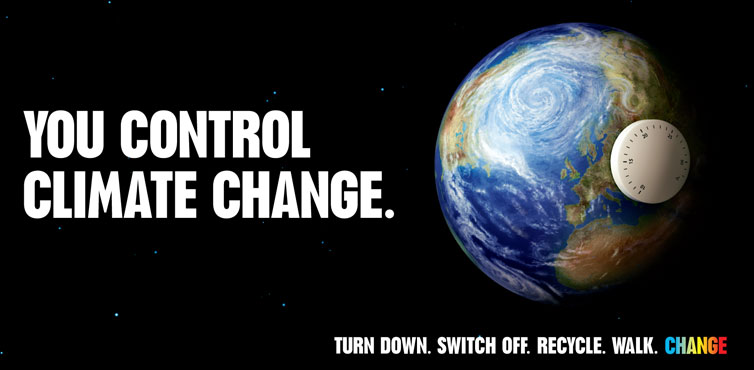
'A change in global or regional climate patterns, in particular a change apparent from the mid to late 20th Century onwards and attributed largely to the increased levels of atmospheric carbon dioxide produced by the use of fossil fuels.' - Definition quoted from the following website, http://www.oxforddictionaries.com/definition/english/climate-change.
Climate change is defined as the shift in the statistic in the weather including it's averages, for an extended period of time. It forms a natural part of the variability of the Earth and is related to the levels of solar radiation reaching the Earth's surface, as well as the interaction between the atmosphere and various geological, geographical, biological and chemical processes that create a complex, yet dynamic Earth system.
Throughout the Earth's history its climate has been subjected to extremes of weather ranging from numerous ice ages to periods of extreme heat, however, this long-term fluctuation in climate is directly affecting both the human and the natural environment, as dramatic shifts in weather automatically alter the productivity of agriculture, the availability of water and the economy. Since the instrumental recording of temperature began in the mid 19th century, the latter part of the 20th century and the early 21st century have seen the highest levels of increases in temperature in the Earth's climate, as evidenced through advances in technology such as earth orbiting satellites and the study of ice cores from the Antarctic. As detailed by the NASA website (http://climate.nasa.gov/evidence/), this acceleration within the Earth's temperature levels have resulted in the following...
- An approximate rise of 17 centimetres (6.7 inches) in the global sea level. = Additional Example - http://www.nationaljournal.com/politics/south-florida-wants-to-be-the-51st-state-because-of-climate-change-worries-20141023.
- Rise in global temperature (20 warmest years since 1981, 10 warmest years in the past 12 years). = Additional Example - http://www.telegraph.co.uk/news/worldnews/australiaandthepacific/australia/10571026/Australias-record-heatwave-melting-bottles-and-fainting-ball-boys.html.
- Increased temperature of the sea (increase of 0.302 degrees Fahrenheit since 1969). Additional Example - http://www.delhidailynews.com/news/Tropics-losing-fish-due-to-rising-sea-temperatures-1413175077/.
- Decrease in the Polar Ice Caps (the Arctic lost an estimated 150-250 cubic kilometres of ice per year, Antarctica lost an estimated 152 cubic kilometres of ice per year, both between 2002-2006). = Additional Example - http://www.theguardian.com/environment/2014/sep/01/new-satellite-maps-show-polar-ice-caps-melting-at-unprecedented-rate.
- Decline in Arctic sea ice. = Additional Example - http://www.neaq.org/conservation_and_research/climate_change/effects_on_ocean_animals.php.
- Global retreat of glaciers. = Additional Example - http://www.bbc.co.uk/news/science-environment-27381010.
- Increase in extreme weather events and natural disasters. = Additional Example - http://www.theguardian.com/environment/blog/2013/nov/29/climate-change-extreme-weather-philippines-typhoon-haiyan.
- Increase in acid located within the sea (additional 2 billion tons of carbon dioxide is absorbed per year into the sea). = Additional Example - http://www.independent.co.uk/news/science/rise-of-acid-ocean-eats-away-base-of-food-chain-8348892.html.
- Decreasing snow cover within the Northern Hemisphere. = Additional Example - http://www.dailymail.co.uk/news/article-2064923/Popular-Austrian-ski-resorts-report-worrying-lack-snow.html.
![This graph, based on the comparison of atmospheric samples contained in ice cores and more recent direct measurements, provides evidence that atmospheric CO<sub>2</sub> has increased since the Industrial Revolution. (Source: [[LINK||http://www.ncdc.noaa.gov/paleo/icecore/||NOAA]])](http://climate.nasa.gov/system/content_pages/main_images/203_co2-graph-1280x800.jpg)
(The measure of Carbon Dioxide levels obtained from Ice Cores, image is taken from the following website http://climate.nasa.gov/evidence/).
Prior to the industrial revolution, climate change occurred predominantly through natural causes such as volcanic eruptions, changes in solar energy and natural changes in greenhouse gases. Scientific research however, has highlighted that the recent increasing rises in temperature cannot be explained in terms of natural causes. Rising levels of carbon dioxide and other greenhouse gases are the direct result of human expansion through the burning of dirty fossil fuels to produce energy, industrial processes and deforestation.
"We live in a greenhouse. Life on Earth depends on energy coming sun. About half the light reaching Earth's atmosphere passes through the air and clouds to the surface, where it is absorbed and then radiated upward in the form of infrared heat. About 90 percent of this heat is then absorbed by the greenhouse gases and radiated back towards the surface, which is warmed to a life-supporting average of 59 degrees Fahrenheit (15 degrees Celsius)." - Quote taken from, http://climate.nasa.gov/causes/.
Personally, I believe that we are too little too late to completely reverse the effects of climate change, our obsession with materialistic luxuries and expansion has manipulated our priorities. Although a small percentage of our populous are grasping the ideology of a renewable lifestyle firmly, the majority are avoiding it like the plague. Gradually, more individuals will except a greener outlook, however, I feel that we will only become 100% united in opinion when something catastrophic occurs, and by this time, it will be too late. Below are two highly distinctive and somewhat grotesque campaign posters created by the WWF, they attempt to highlight the severity of climate change as a way of informing the populous that it is necessary for us to adapt in order to improve the current environmental situation. Personally, I find that the WWF's campaign/advertising posters are both innovative and powerful, thus indicating that their message will be more prominently received, however, if we are to substantially transform our lifestyle (and resultantly, our carbon footprint) it is going to take the union of a much larger volume of people than just organisations such as the WWF.


Our acceptance of alternative, more renewable areas of design is paramount in the battle against climate change as it withholds the potential to confront the industries responsible for mass production. It conceals the key to unlocking a more biodegradable, cost-effective and sustainable area of manufacturing, allowing the public to become more accustomed to an element of a greener lifestyle, which would thus have an increasingly positive impact on the environment. The more companies that adopted renewable design and manufacturing would, the more significant the reduction of our carbon footprint as it would have a direct impact on the emissions resultant from making and then transporting the goods.

(Pie Chart of The U.S Carbon Dioxide Emissions =
Taken from the following website
http://www.epa.gov/climatechange/ghgemissions/gases/co2.html
- "Note: All emission estimates from 'The Inventory of U.S Greenhouse
Gas Emissions and Sinks: 1990-2012'")
http://www.metoffice.gov.uk/climate-guide/climate-change
http://www.metoffice.gov.uk/climate-guide/climate-change/why
http://www.metoffice.gov.uk/climate-guide/climate-change/impacts/human-activity
No comments:
Post a Comment